Accounts and Finance Report: ABC and Absorption Costing Analysis
VerifiedAdded on 2021/04/21
|9
|1747
|31
Report
AI Summary
This report provides a comprehensive analysis of two primary costing methods: activity-based costing (ABC) and absorption costing. It begins by explaining the traditional methods of overhead allocation and critiques their relevance in modern manufacturing environments. The report then delves into ABC, detailing its systematic approach to allocating overhead costs based on activities and cost drivers, with a practical example illustrating its application. It also discusses the limitations of ABC, such as the time-consuming implementation process. The report then transitions to absorption costing, defining its method of accumulating costs and allocating them to products. It includes an example calculation and identifies limitations, such as dependence on output levels and potential for arbitrary overhead allocation. Finally, the report concludes by comparing the two methods, recommending ABC for decision-making due to its structured data and ability to identify areas for cost minimization, while suggesting that absorption costing is less useful for managerial decisions like product mix and make-or-buy choices. The report provides valuable insights into these costing techniques, supported by references to relevant academic sources.
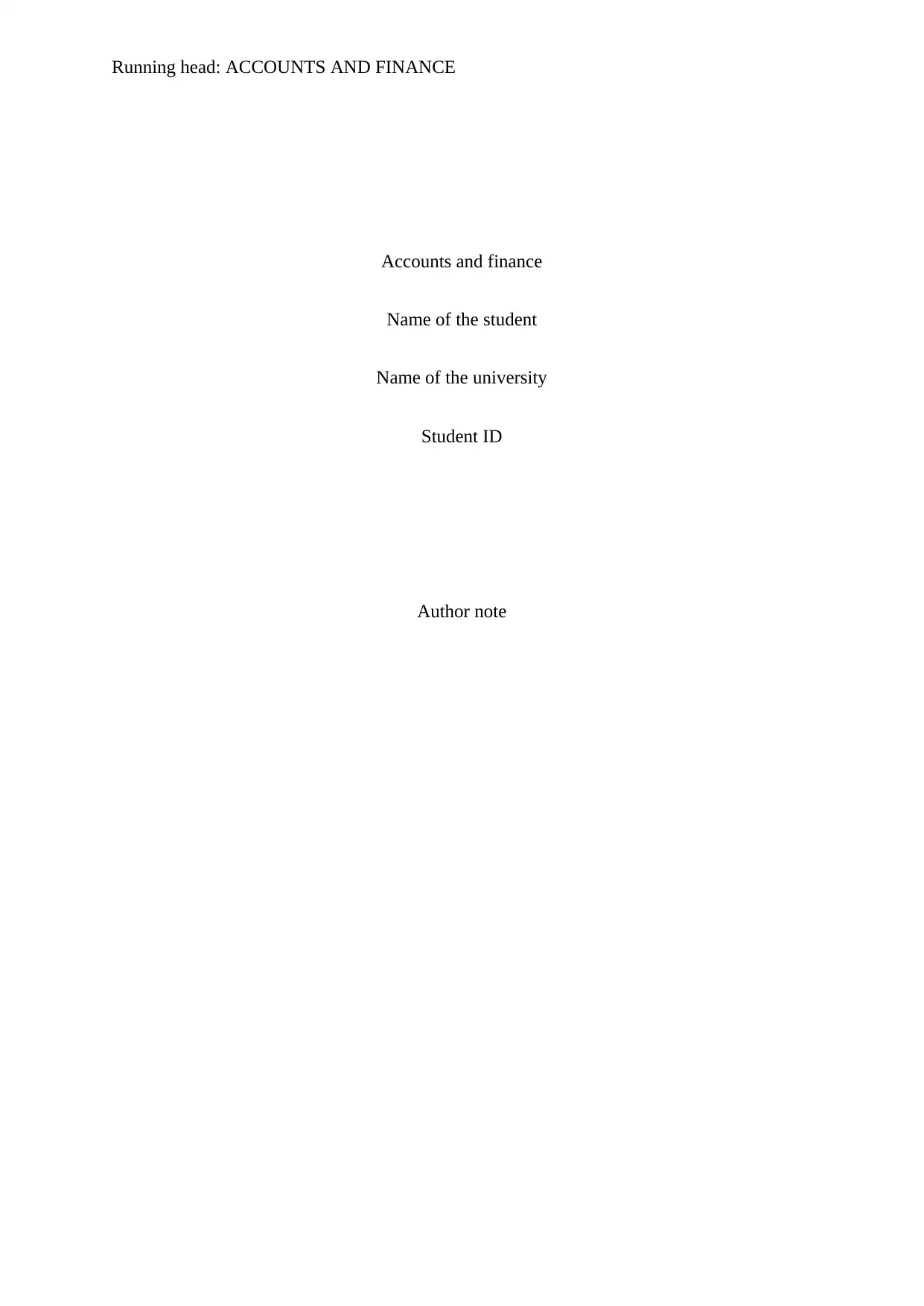
Running head: ACCOUNTS AND FINANCE
Accounts and finance
Name of the student
Name of the university
Student ID
Author note
Accounts and finance
Name of the student
Name of the university
Student ID
Author note
Paraphrase This Document
Need a fresh take? Get an instant paraphrase of this document with our AI Paraphraser
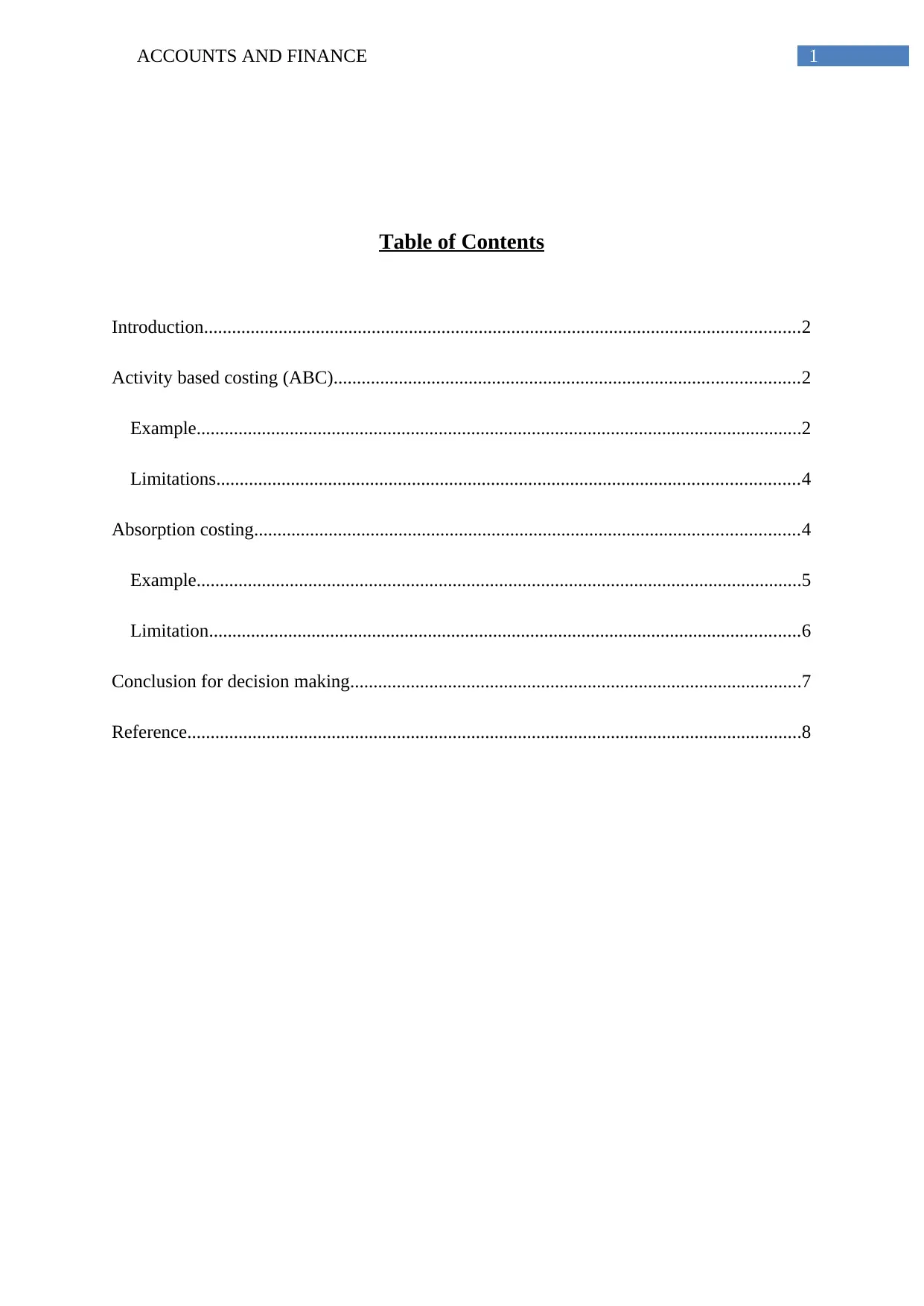
1ACCOUNTS AND FINANCE
Table of Contents
Introduction................................................................................................................................2
Activity based costing (ABC)....................................................................................................2
Example..................................................................................................................................2
Limitations.............................................................................................................................4
Absorption costing.....................................................................................................................4
Example..................................................................................................................................5
Limitation...............................................................................................................................6
Conclusion for decision making.................................................................................................7
Reference....................................................................................................................................8
Table of Contents
Introduction................................................................................................................................2
Activity based costing (ABC)....................................................................................................2
Example..................................................................................................................................2
Limitations.............................................................................................................................4
Absorption costing.....................................................................................................................4
Example..................................................................................................................................5
Limitation...............................................................................................................................6
Conclusion for decision making.................................................................................................7
Reference....................................................................................................................................8
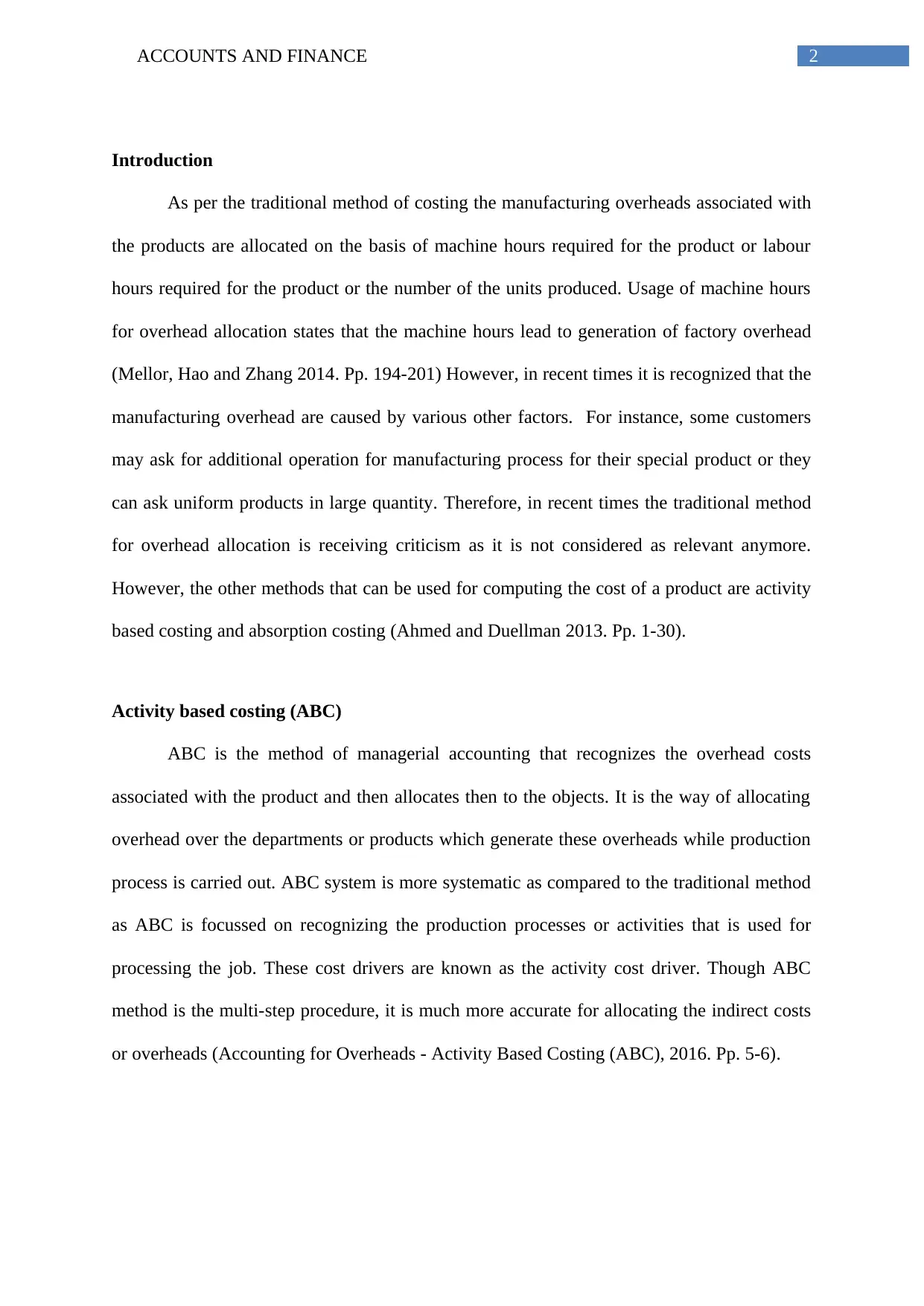
2ACCOUNTS AND FINANCE
Introduction
As per the traditional method of costing the manufacturing overheads associated with
the products are allocated on the basis of machine hours required for the product or labour
hours required for the product or the number of the units produced. Usage of machine hours
for overhead allocation states that the machine hours lead to generation of factory overhead
(Mellor, Hao and Zhang 2014. Pp. 194-201) However, in recent times it is recognized that the
manufacturing overhead are caused by various other factors. For instance, some customers
may ask for additional operation for manufacturing process for their special product or they
can ask uniform products in large quantity. Therefore, in recent times the traditional method
for overhead allocation is receiving criticism as it is not considered as relevant anymore.
However, the other methods that can be used for computing the cost of a product are activity
based costing and absorption costing (Ahmed and Duellman 2013. Pp. 1-30).
Activity based costing (ABC)
ABC is the method of managerial accounting that recognizes the overhead costs
associated with the product and then allocates then to the objects. It is the way of allocating
overhead over the departments or products which generate these overheads while production
process is carried out. ABC system is more systematic as compared to the traditional method
as ABC is focussed on recognizing the production processes or activities that is used for
processing the job. These cost drivers are known as the activity cost driver. Though ABC
method is the multi-step procedure, it is much more accurate for allocating the indirect costs
or overheads (Accounting for Overheads - Activity Based Costing (ABC), 2016. Pp. 5-6).
Introduction
As per the traditional method of costing the manufacturing overheads associated with
the products are allocated on the basis of machine hours required for the product or labour
hours required for the product or the number of the units produced. Usage of machine hours
for overhead allocation states that the machine hours lead to generation of factory overhead
(Mellor, Hao and Zhang 2014. Pp. 194-201) However, in recent times it is recognized that the
manufacturing overhead are caused by various other factors. For instance, some customers
may ask for additional operation for manufacturing process for their special product or they
can ask uniform products in large quantity. Therefore, in recent times the traditional method
for overhead allocation is receiving criticism as it is not considered as relevant anymore.
However, the other methods that can be used for computing the cost of a product are activity
based costing and absorption costing (Ahmed and Duellman 2013. Pp. 1-30).
Activity based costing (ABC)
ABC is the method of managerial accounting that recognizes the overhead costs
associated with the product and then allocates then to the objects. It is the way of allocating
overhead over the departments or products which generate these overheads while production
process is carried out. ABC system is more systematic as compared to the traditional method
as ABC is focussed on recognizing the production processes or activities that is used for
processing the job. These cost drivers are known as the activity cost driver. Though ABC
method is the multi-step procedure, it is much more accurate for allocating the indirect costs
or overheads (Accounting for Overheads - Activity Based Costing (ABC), 2016. Pp. 5-6).
⊘ This is a preview!⊘
Do you want full access?
Subscribe today to unlock all pages.

Trusted by 1+ million students worldwide
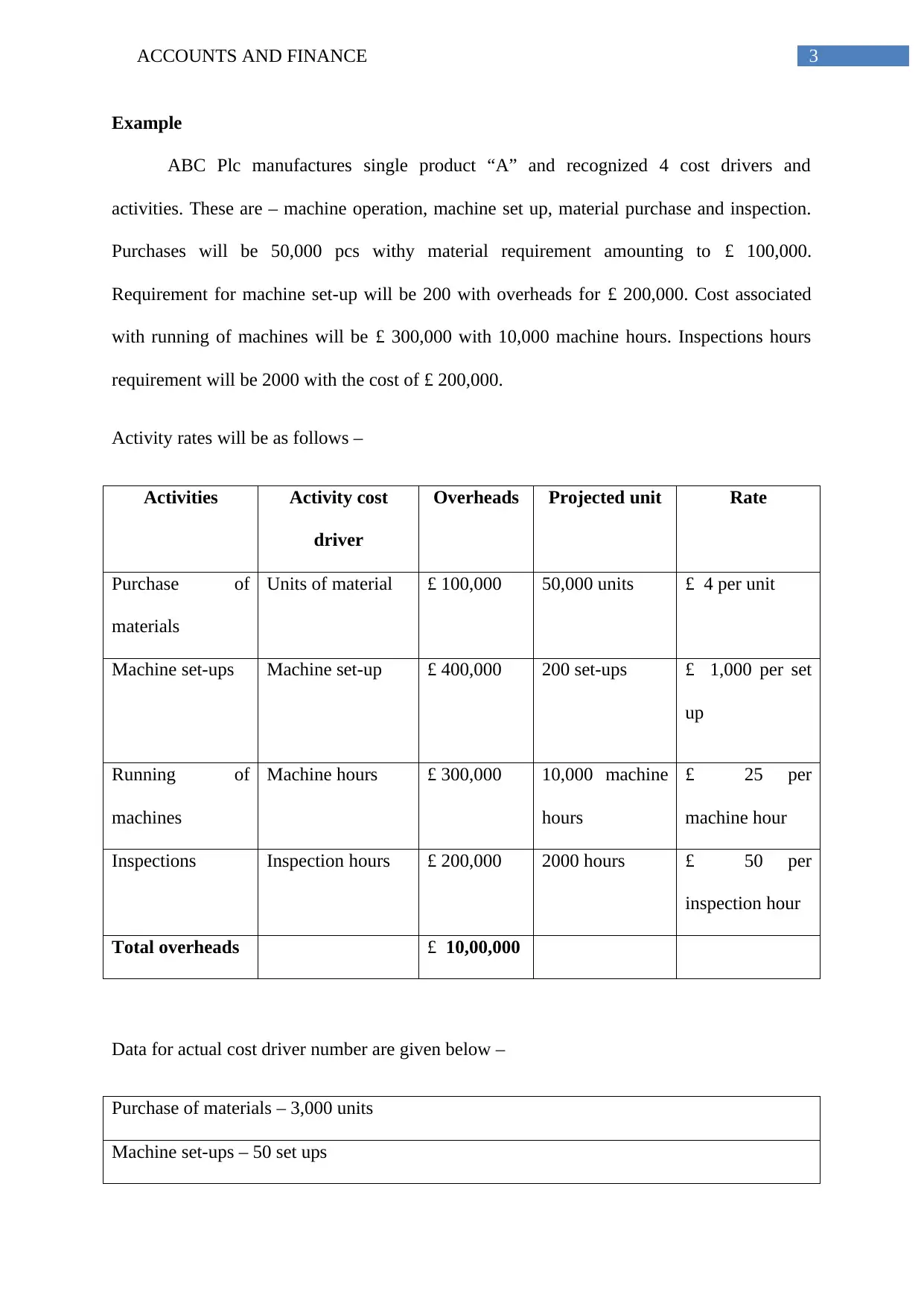
3ACCOUNTS AND FINANCE
Example
ABC Plc manufactures single product “A” and recognized 4 cost drivers and
activities. These are – machine operation, machine set up, material purchase and inspection.
Purchases will be 50,000 pcs withy material requirement amounting to £ 100,000.
Requirement for machine set-up will be 200 with overheads for £ 200,000. Cost associated
with running of machines will be £ 300,000 with 10,000 machine hours. Inspections hours
requirement will be 2000 with the cost of £ 200,000.
Activity rates will be as follows –
Activities Activity cost
driver
Overheads Projected unit Rate
Purchase of
materials
Units of material £ 100,000 50,000 units £ 4 per unit
Machine set-ups Machine set-up £ 400,000 200 set-ups £ 1,000 per set
up
Running of
machines
Machine hours £ 300,000 10,000 machine
hours
£ 25 per
machine hour
Inspections Inspection hours £ 200,000 2000 hours £ 50 per
inspection hour
Total overheads £ 10,00,000
Data for actual cost driver number are given below –
Purchase of materials – 3,000 units
Machine set-ups – 50 set ups
Example
ABC Plc manufactures single product “A” and recognized 4 cost drivers and
activities. These are – machine operation, machine set up, material purchase and inspection.
Purchases will be 50,000 pcs withy material requirement amounting to £ 100,000.
Requirement for machine set-up will be 200 with overheads for £ 200,000. Cost associated
with running of machines will be £ 300,000 with 10,000 machine hours. Inspections hours
requirement will be 2000 with the cost of £ 200,000.
Activity rates will be as follows –
Activities Activity cost
driver
Overheads Projected unit Rate
Purchase of
materials
Units of material £ 100,000 50,000 units £ 4 per unit
Machine set-ups Machine set-up £ 400,000 200 set-ups £ 1,000 per set
up
Running of
machines
Machine hours £ 300,000 10,000 machine
hours
£ 25 per
machine hour
Inspections Inspection hours £ 200,000 2000 hours £ 50 per
inspection hour
Total overheads £ 10,00,000
Data for actual cost driver number are given below –
Purchase of materials – 3,000 units
Machine set-ups – 50 set ups
Paraphrase This Document
Need a fresh take? Get an instant paraphrase of this document with our AI Paraphraser
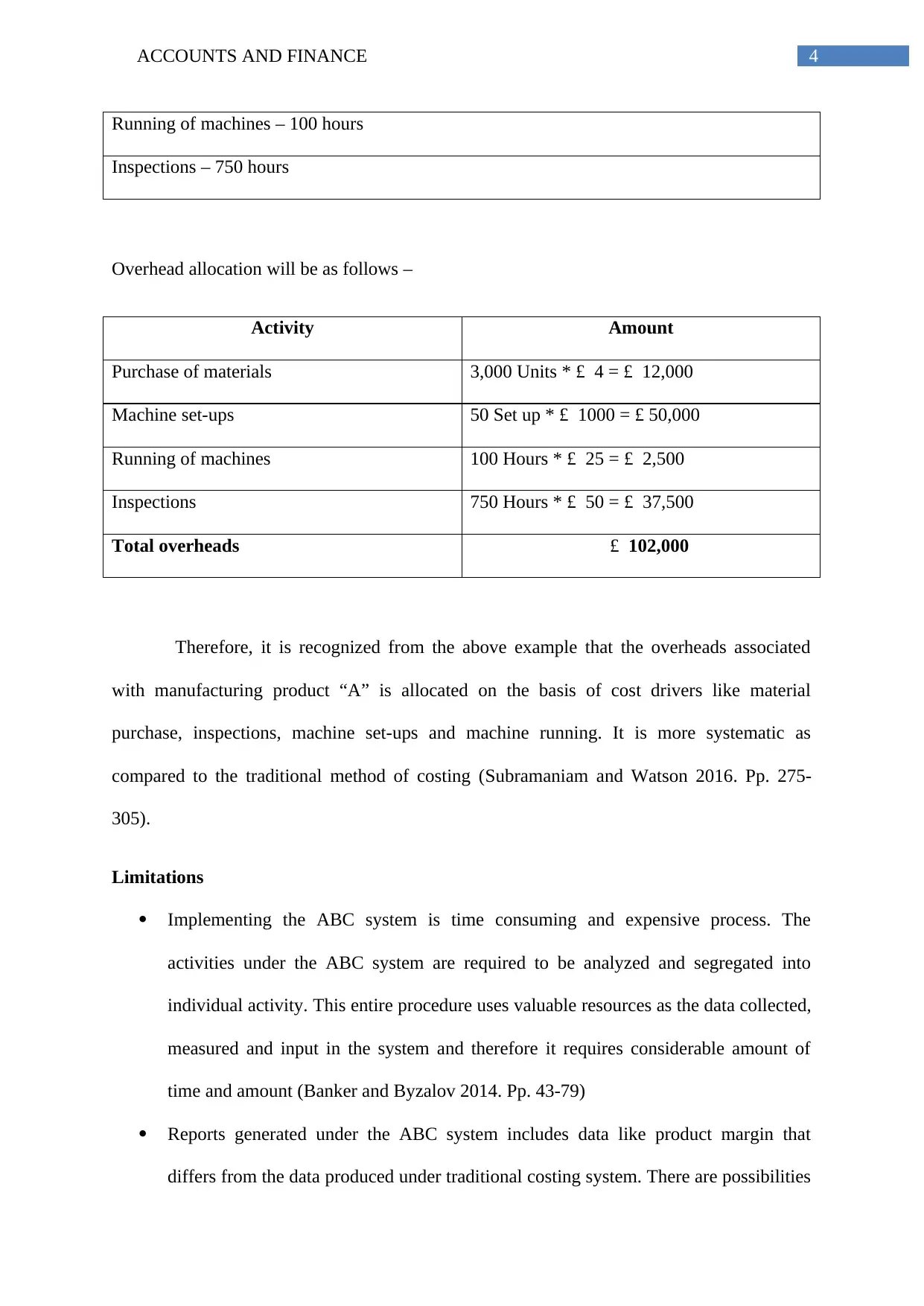
4ACCOUNTS AND FINANCE
Running of machines – 100 hours
Inspections – 750 hours
Overhead allocation will be as follows –
Activity Amount
Purchase of materials 3,000 Units * £ 4 = £ 12,000
Machine set-ups 50 Set up * £ 1000 = £ 50,000
Running of machines 100 Hours * £ 25 = £ 2,500
Inspections 750 Hours * £ 50 = £ 37,500
Total overheads £ 102,000
Therefore, it is recognized from the above example that the overheads associated
with manufacturing product “A” is allocated on the basis of cost drivers like material
purchase, inspections, machine set-ups and machine running. It is more systematic as
compared to the traditional method of costing (Subramaniam and Watson 2016. Pp. 275-
305).
Limitations
Implementing the ABC system is time consuming and expensive process. The
activities under the ABC system are required to be analyzed and segregated into
individual activity. This entire procedure uses valuable resources as the data collected,
measured and input in the system and therefore it requires considerable amount of
time and amount (Banker and Byzalov 2014. Pp. 43-79)
Reports generated under the ABC system includes data like product margin that
differs from the data produced under traditional costing system. There are possibilities
Running of machines – 100 hours
Inspections – 750 hours
Overhead allocation will be as follows –
Activity Amount
Purchase of materials 3,000 Units * £ 4 = £ 12,000
Machine set-ups 50 Set up * £ 1000 = £ 50,000
Running of machines 100 Hours * £ 25 = £ 2,500
Inspections 750 Hours * £ 50 = £ 37,500
Total overheads £ 102,000
Therefore, it is recognized from the above example that the overheads associated
with manufacturing product “A” is allocated on the basis of cost drivers like material
purchase, inspections, machine set-ups and machine running. It is more systematic as
compared to the traditional method of costing (Subramaniam and Watson 2016. Pp. 275-
305).
Limitations
Implementing the ABC system is time consuming and expensive process. The
activities under the ABC system are required to be analyzed and segregated into
individual activity. This entire procedure uses valuable resources as the data collected,
measured and input in the system and therefore it requires considerable amount of
time and amount (Banker and Byzalov 2014. Pp. 43-79)
Reports generated under the ABC system includes data like product margin that
differs from the data produced under traditional costing system. There are possibilities
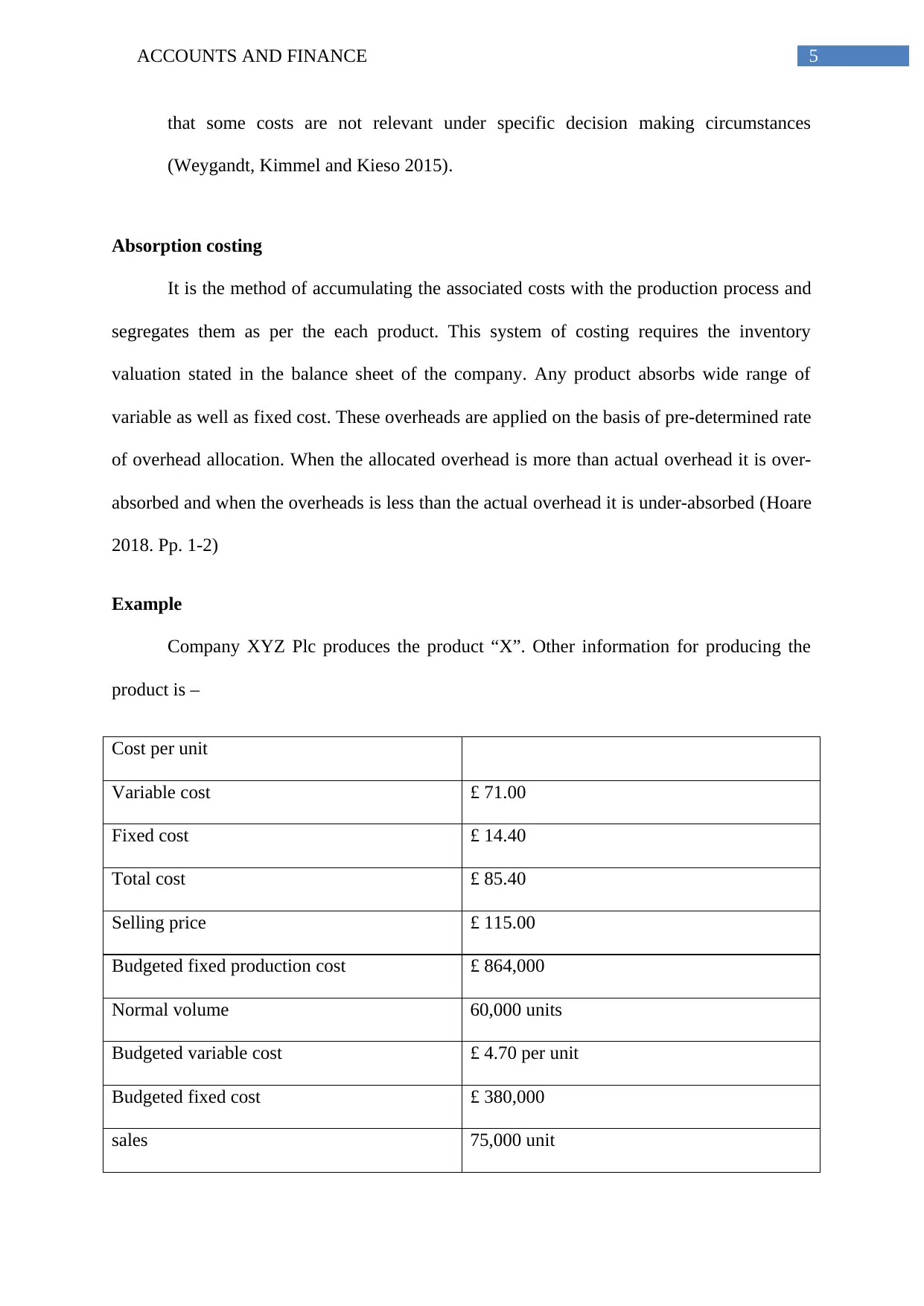
5ACCOUNTS AND FINANCE
that some costs are not relevant under specific decision making circumstances
(Weygandt, Kimmel and Kieso 2015).
Absorption costing
It is the method of accumulating the associated costs with the production process and
segregates them as per the each product. This system of costing requires the inventory
valuation stated in the balance sheet of the company. Any product absorbs wide range of
variable as well as fixed cost. These overheads are applied on the basis of pre-determined rate
of overhead allocation. When the allocated overhead is more than actual overhead it is over-
absorbed and when the overheads is less than the actual overhead it is under-absorbed (Hoare
2018. Pp. 1-2)
Example
Company XYZ Plc produces the product “X”. Other information for producing the
product is –
Cost per unit
Variable cost £ 71.00
Fixed cost £ 14.40
Total cost £ 85.40
Selling price £ 115.00
Budgeted fixed production cost £ 864,000
Normal volume 60,000 units
Budgeted variable cost £ 4.70 per unit
Budgeted fixed cost £ 380,000
sales 75,000 unit
that some costs are not relevant under specific decision making circumstances
(Weygandt, Kimmel and Kieso 2015).
Absorption costing
It is the method of accumulating the associated costs with the production process and
segregates them as per the each product. This system of costing requires the inventory
valuation stated in the balance sheet of the company. Any product absorbs wide range of
variable as well as fixed cost. These overheads are applied on the basis of pre-determined rate
of overhead allocation. When the allocated overhead is more than actual overhead it is over-
absorbed and when the overheads is less than the actual overhead it is under-absorbed (Hoare
2018. Pp. 1-2)
Example
Company XYZ Plc produces the product “X”. Other information for producing the
product is –
Cost per unit
Variable cost £ 71.00
Fixed cost £ 14.40
Total cost £ 85.40
Selling price £ 115.00
Budgeted fixed production cost £ 864,000
Normal volume 60,000 units
Budgeted variable cost £ 4.70 per unit
Budgeted fixed cost £ 380,000
sales 75,000 unit
⊘ This is a preview!⊘
Do you want full access?
Subscribe today to unlock all pages.

Trusted by 1+ million students worldwide
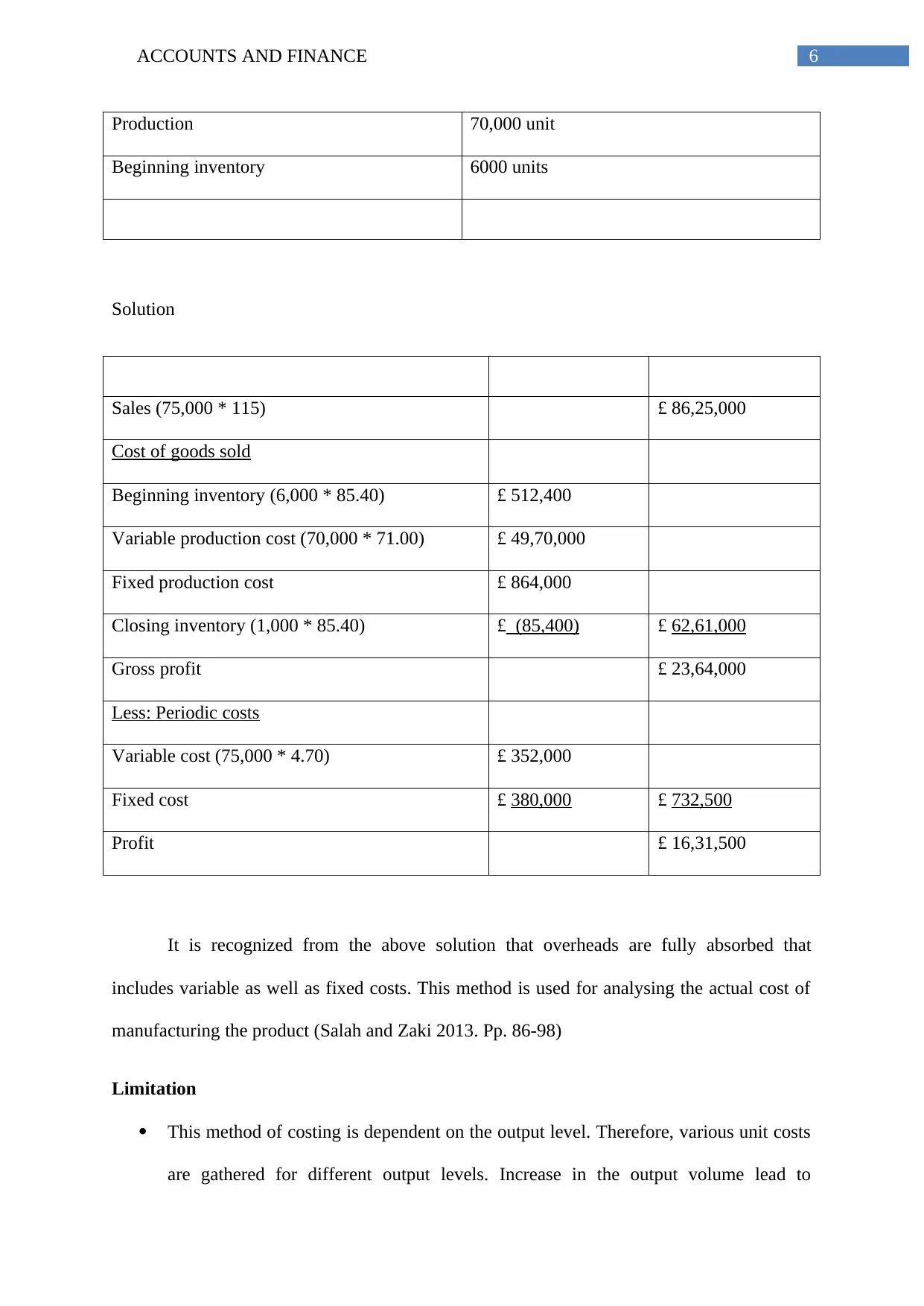
6ACCOUNTS AND FINANCE
Production 70,000 unit
Beginning inventory 6000 units
Solution
Sales (75,000 * 115) £ 86,25,000
Cost of goods sold
Beginning inventory (6,000 * 85.40) £ 512,400
Variable production cost (70,000 * 71.00) £ 49,70,000
Fixed production cost £ 864,000
Closing inventory (1,000 * 85.40) £ (85,400) £ 62,61,000
Gross profit £ 23,64,000
Less: Periodic costs
Variable cost (75,000 * 4.70) £ 352,000
Fixed cost £ 380,000 £ 732,500
Profit £ 16,31,500
It is recognized from the above solution that overheads are fully absorbed that
includes variable as well as fixed costs. This method is used for analysing the actual cost of
manufacturing the product (Salah and Zaki 2013. Pp. 86-98)
Limitation
This method of costing is dependent on the output level. Therefore, various unit costs
are gathered for different output levels. Increase in the output volume lead to
Production 70,000 unit
Beginning inventory 6000 units
Solution
Sales (75,000 * 115) £ 86,25,000
Cost of goods sold
Beginning inventory (6,000 * 85.40) £ 512,400
Variable production cost (70,000 * 71.00) £ 49,70,000
Fixed production cost £ 864,000
Closing inventory (1,000 * 85.40) £ (85,400) £ 62,61,000
Gross profit £ 23,64,000
Less: Periodic costs
Variable cost (75,000 * 4.70) £ 352,000
Fixed cost £ 380,000 £ 732,500
Profit £ 16,31,500
It is recognized from the above solution that overheads are fully absorbed that
includes variable as well as fixed costs. This method is used for analysing the actual cost of
manufacturing the product (Salah and Zaki 2013. Pp. 86-98)
Limitation
This method of costing is dependent on the output level. Therefore, various unit costs
are gathered for different output levels. Increase in the output volume lead to
Paraphrase This Document
Need a fresh take? Get an instant paraphrase of this document with our AI Paraphraser
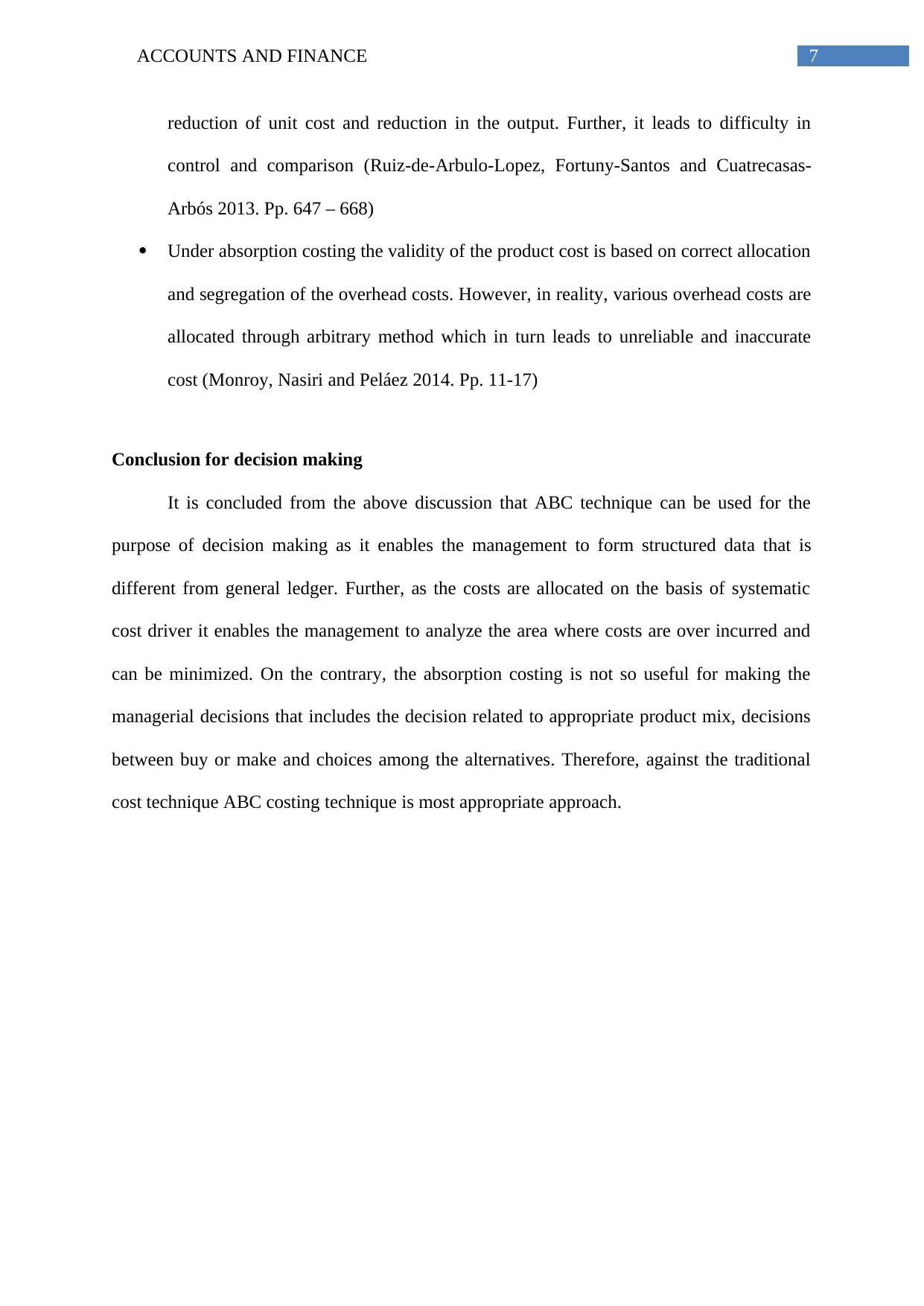
7ACCOUNTS AND FINANCE
reduction of unit cost and reduction in the output. Further, it leads to difficulty in
control and comparison (Ruiz-de-Arbulo-Lopez, Fortuny-Santos and Cuatrecasas-
Arbós 2013. Pp. 647 – 668)
Under absorption costing the validity of the product cost is based on correct allocation
and segregation of the overhead costs. However, in reality, various overhead costs are
allocated through arbitrary method which in turn leads to unreliable and inaccurate
cost (Monroy, Nasiri and Peláez 2014. Pp. 11-17)
Conclusion for decision making
It is concluded from the above discussion that ABC technique can be used for the
purpose of decision making as it enables the management to form structured data that is
different from general ledger. Further, as the costs are allocated on the basis of systematic
cost driver it enables the management to analyze the area where costs are over incurred and
can be minimized. On the contrary, the absorption costing is not so useful for making the
managerial decisions that includes the decision related to appropriate product mix, decisions
between buy or make and choices among the alternatives. Therefore, against the traditional
cost technique ABC costing technique is most appropriate approach.
reduction of unit cost and reduction in the output. Further, it leads to difficulty in
control and comparison (Ruiz-de-Arbulo-Lopez, Fortuny-Santos and Cuatrecasas-
Arbós 2013. Pp. 647 – 668)
Under absorption costing the validity of the product cost is based on correct allocation
and segregation of the overhead costs. However, in reality, various overhead costs are
allocated through arbitrary method which in turn leads to unreliable and inaccurate
cost (Monroy, Nasiri and Peláez 2014. Pp. 11-17)
Conclusion for decision making
It is concluded from the above discussion that ABC technique can be used for the
purpose of decision making as it enables the management to form structured data that is
different from general ledger. Further, as the costs are allocated on the basis of systematic
cost driver it enables the management to analyze the area where costs are over incurred and
can be minimized. On the contrary, the absorption costing is not so useful for making the
managerial decisions that includes the decision related to appropriate product mix, decisions
between buy or make and choices among the alternatives. Therefore, against the traditional
cost technique ABC costing technique is most appropriate approach.
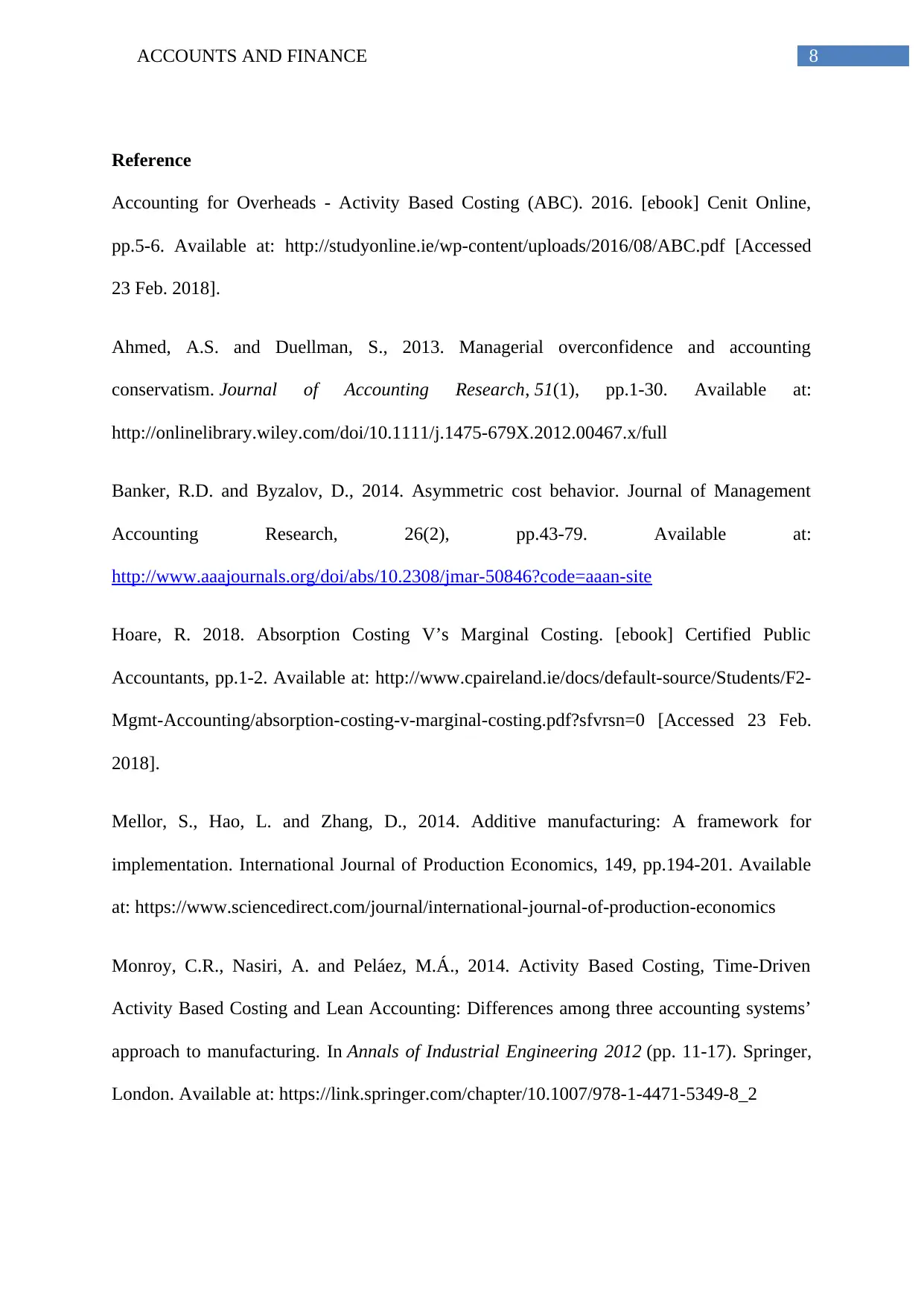
8ACCOUNTS AND FINANCE
Reference
Accounting for Overheads - Activity Based Costing (ABC). 2016. [ebook] Cenit Online,
pp.5-6. Available at: http://studyonline.ie/wp-content/uploads/2016/08/ABC.pdf [Accessed
23 Feb. 2018].
Ahmed, A.S. and Duellman, S., 2013. Managerial overconfidence and accounting
conservatism. Journal of Accounting Research, 51(1), pp.1-30. Available at:
http://onlinelibrary.wiley.com/doi/10.1111/j.1475-679X.2012.00467.x/full
Banker, R.D. and Byzalov, D., 2014. Asymmetric cost behavior. Journal of Management
Accounting Research, 26(2), pp.43-79. Available at:
http://www.aaajournals.org/doi/abs/10.2308/jmar-50846?code=aaan-site
Hoare, R. 2018. Absorption Costing V’s Marginal Costing. [ebook] Certified Public
Accountants, pp.1-2. Available at: http://www.cpaireland.ie/docs/default-source/Students/F2-
Mgmt-Accounting/absorption-costing-v-marginal-costing.pdf?sfvrsn=0 [Accessed 23 Feb.
2018].
Mellor, S., Hao, L. and Zhang, D., 2014. Additive manufacturing: A framework for
implementation. International Journal of Production Economics, 149, pp.194-201. Available
at: https://www.sciencedirect.com/journal/international-journal-of-production-economics
Monroy, C.R., Nasiri, A. and Peláez, M.Á., 2014. Activity Based Costing, Time-Driven
Activity Based Costing and Lean Accounting: Differences among three accounting systems’
approach to manufacturing. In Annals of Industrial Engineering 2012 (pp. 11-17). Springer,
London. Available at: https://link.springer.com/chapter/10.1007/978-1-4471-5349-8_2
Reference
Accounting for Overheads - Activity Based Costing (ABC). 2016. [ebook] Cenit Online,
pp.5-6. Available at: http://studyonline.ie/wp-content/uploads/2016/08/ABC.pdf [Accessed
23 Feb. 2018].
Ahmed, A.S. and Duellman, S., 2013. Managerial overconfidence and accounting
conservatism. Journal of Accounting Research, 51(1), pp.1-30. Available at:
http://onlinelibrary.wiley.com/doi/10.1111/j.1475-679X.2012.00467.x/full
Banker, R.D. and Byzalov, D., 2014. Asymmetric cost behavior. Journal of Management
Accounting Research, 26(2), pp.43-79. Available at:
http://www.aaajournals.org/doi/abs/10.2308/jmar-50846?code=aaan-site
Hoare, R. 2018. Absorption Costing V’s Marginal Costing. [ebook] Certified Public
Accountants, pp.1-2. Available at: http://www.cpaireland.ie/docs/default-source/Students/F2-
Mgmt-Accounting/absorption-costing-v-marginal-costing.pdf?sfvrsn=0 [Accessed 23 Feb.
2018].
Mellor, S., Hao, L. and Zhang, D., 2014. Additive manufacturing: A framework for
implementation. International Journal of Production Economics, 149, pp.194-201. Available
at: https://www.sciencedirect.com/journal/international-journal-of-production-economics
Monroy, C.R., Nasiri, A. and Peláez, M.Á., 2014. Activity Based Costing, Time-Driven
Activity Based Costing and Lean Accounting: Differences among three accounting systems’
approach to manufacturing. In Annals of Industrial Engineering 2012 (pp. 11-17). Springer,
London. Available at: https://link.springer.com/chapter/10.1007/978-1-4471-5349-8_2
⊘ This is a preview!⊘
Do you want full access?
Subscribe today to unlock all pages.

Trusted by 1+ million students worldwide
1 out of 9
Related Documents
Your All-in-One AI-Powered Toolkit for Academic Success.
+13062052269
info@desklib.com
Available 24*7 on WhatsApp / Email
![[object Object]](/_next/static/media/star-bottom.7253800d.svg)
Unlock your academic potential
Copyright © 2020–2025 A2Z Services. All Rights Reserved. Developed and managed by ZUCOL.





